Growing Blog
Grower Profile: Cascadia Mushrooms in Bellingham, Washington

At first glance, mushroom mycelium can be somewhat unassuming.
Because it doesn’t look like much is happening, the casual observer might not expect anything from this white filament like substance, slowly feasting its way across organic matter.
But behind this humble appearance hides an enormous amount of potential energy, which- if properly handled- can be unleashed in the form of delicious gourmet mushrooms.
This is where Alex Winstead comes in, apex grower and owner of Cascadia Mushrooms.
Starting in 2005, Alex has been honing his skills, artfully controlling that mycelial power and growing Shiitake, Oysters, Pionpinnis and more from his operation in Bellingham Washington.
Now, Cascadia Mushrooms provides hundreds of pounds of fresh, organic mushrooms per week to the restaurants, farmers markets and grocery stores throughout Northwest Washington.
I’ve known about Cascadia for a while- always being super impressed by what Alex is up to.
Recently, I was lucky enough to go visit this awesome farm and see for myself how it’s done!
Designed For Efficiency
You can tell that Alex has put serious thought into the flow of his operation.
Starting from the pile of substrate at the entrance to the property, there is a logical and consistent movement throughout the entire farm, each step of the cultivation process naturally progressing from the last.
Eventually, fresh, organic mushrooms are pulled from a cooler and placed into a van for delivery.
Growing mushrooms takes a ton of labor, and designing the farm with operational efficiency as a priority is one of the major reasons why Cascadia Mushrooms is such a success.

Substrate
This is where it all begins.
Alex uses locally sourced hardwood sawdust for the bulk of his substrate. It’s a standard mix of red alder sawdust, which is delivered right to his farm. Having an abundance of cheap local hardwood is a major advantage of growing in the Washington area- since it’s basically a waste product from other industries.
At the farm, Alex grows King Oysters, Pearl Oysters, Pink Oysters, Reishi, Lion’s Mane, Pioppino, and Shiitake, all of which are grown on the same substrate mix.
The only difference is the amount of supplementation that goes into the mix for each different species. Interestingly, of all the species he grows, Shiitake receives the highest amount of additional nutrition.
The supplement used at Cascadia is wheat “middlings” also known as wheat “mill run”, a non-flour by product of the wheat milling process.
Middlings contains fractions of the endosperm, the bran, and the germ of wheat. It’s a cost effective, organic supplement that works great for nutrifying the block and gives the mycelium what it needs to produce the best fruit.
In addition to this, they also mix in whole organic wheat berries to the substrate.
This adds some extra protein and carbohydrates, but is primarily used to absorb water during the sterilization process- helping to retain moisture in the final mix.
Even though Alex grows a wide variety of species, the vast majority of his crop is organic Shiitake.
When asked why, he explained that “Shiitake is what his customers want.” Even though the desire for exotic gourmet mushrooms is growing every day, most people still just want the mushrooms they are most familiar with.
This is a slightly different story at the farmers market however, where it is easier to “wow” passers by with brightly colored Pink Oysters and weird looking Lion’s Mane.
Mixing and Packing
In order to pack the bags, the hardwood sawdust is mixed in a large custom made hopper with the bran and grain added for nutrition. Water is added until the substrate has the right consistency, and then is packed into bags. He doesn’t measure the water by weight or volume, just goes by feel while filling the bags.
The fruiting blocks are made to be different sizes depending on the species they will be inoculated with. Most blocks are 6-8 lbs, before the grain spawn is added- but the shiitake blocks are made to be only 4-5 lbs.
The reason for the smaller blocks, again, is because of operational efficiency and the fact that Shiitake has some unique growing parameters.
For one, the entire bag needs to be removed from the block in order to fruit. This takes some time and handling to do for shiitake, rather than oysters which simply require a slit in the bag.
Secondly, the mushrooms are harvested by holding the entire block in one hand, while cutting the fruits off using with a knife in the other hand. Unless you are an NBA basketball player, this would be pretty tough to do with an 8 lb block!
Amazingly, Alex estimates that each Shiitake fruiting block is handled 50-60 times before it is finally set into the compost pile. This type of repetitive handling really adds up, and is one of the reasons why mushroom farming can be so labor intensive. It highlights the importance of efficiency and proper flow through each of the processes, which Cascadia has really nailed down over the years.
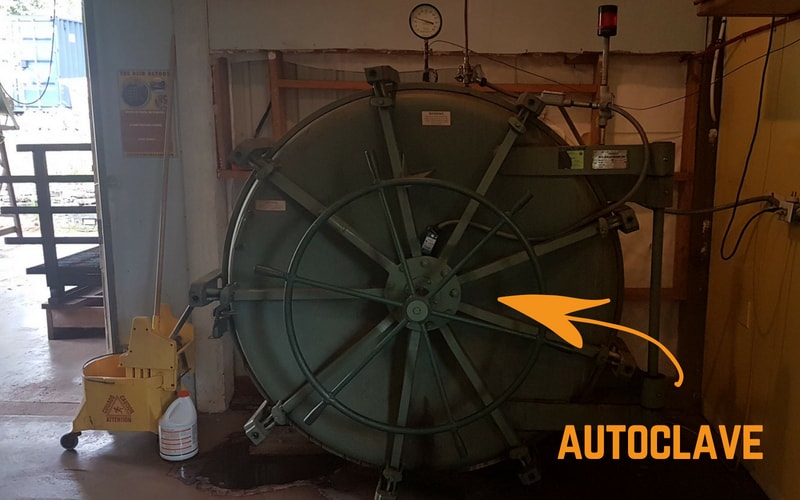
Sterilizing
When it comes to sterilizing substrates at Cascadia, Alex doesn’t mess around.
Installed just downstream of the mixing area is a large capacity autoclave, able to sterilize about 600 bags in a single run. The autoclave runs at 15 PSI, and takes a full day for a complete sterilization cycle from start to finish.
There are a few key advantages to using a large commercial autoclave.
First of all, Alex is able to load the packed bags onto carts that work with a system of pallet jacks and rails. This makes it easy to roll the bags into and out of the autoclave, and reduces individual handling of the bags.
Also, as soon as the sterilization cycle is completed, the hot bags can be easily rolled out of the autoclave and directly into the lab- where they can cool down in a clean environment. If you had to wait for them to cool down before removing them, you’d be waiting a long time.
Pulling the bags out of the sterilizer right away allows Alex to perform multiple sterilization runs in a single week, typically three.
The other benefit is cost. Although the initial investment for setting up a large autoclave is high, the long term fuel costs are much cheaper than if using multiple propane burners. Alex estimates that the fuel cost for a single run is under $20, which equates to only $0.03 per bag– an almost negligible cost.
There can be safety concerns, however, which is why the state mandates annual inspections and testing of the entire steam system. This probably sounds like more of a pain than it actually is.
That being said, boilers are high pressure, high temperature, relatively complex pieces of equipment.
Safety first folks!
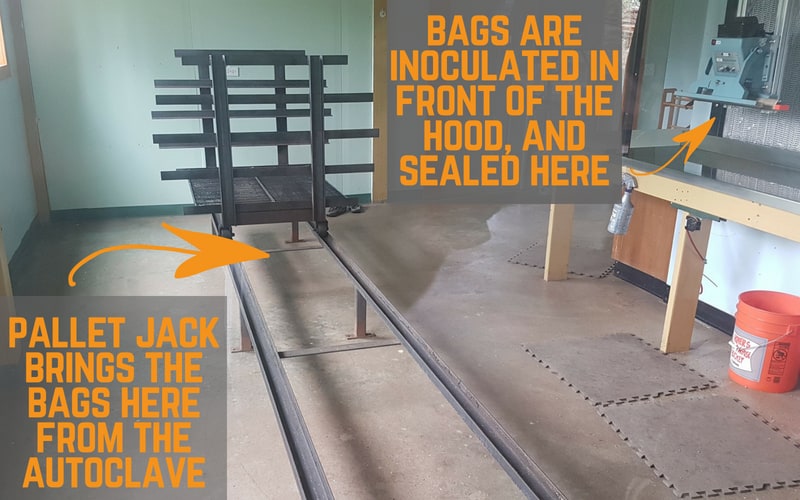
Inoculation in the Lab
Directly downstream from the autoclave is a good sized laboratory, nicely outfitted with large laminar flow hoods on a stainless tabletop.
The entire lab is under positive pressure, and supplied fresh air through a HEPA filter. Standing outside the lab, you can feel a stream of air pushing out between the doors. This positive pressure keeps the lab clean and minimizes the contamination from outside air.
The bags are inoculated by a team of three people- one adding spawn, one sealing the bags, and one mixing the bags up by hand.
Since Cascadia Mushrooms inoculates approximately 1500-1800 bags per week, it’s good to have this system nailed down. Any extra steps, or loss in efficiency here can really add up over time.
Interestingly, only about 1 tablespoon of spawn is used to inoculate each bag.
Although this doesn’t seem like enough, Alex says that the bags still are able to colonize rather quickly, and he doesn’t see high amounts of contamination. If you think about it, you could technically inoculate an entire fruiting block with only one grain of spawn, although that would likely have diminishing returns!
The Shiitake colonizes for over two months, so using less spawn doesn’t affect the overall colonization time that much anyways.
Using less spawn per bag goes back to optimization and efficiency. For Cascadia, spawn is an important input cost- so reducing the amount that is used for inoculation can really have a serious impact on the bottom line.
Once inoculated, the bags are sealed using a machine that hangs down from the top of the flow hood, able to stay in a clean stream of air the whole time. This is better than sealing the bags with a cumbersome piece of wire or zip tip, and allows the person sealing bags to work quickly and efficiently.
Of course, contamination issues still crop up from time to time. Alex says more often than not, any contamination is simply caused by bad spawn. Other times, it might be because the sterilization process was incomplete.
Sometimes however, the reason for contamination is never known. It could be operator error, a fly in the lab, the list goes on. Overall though, contamination rates are quite low.
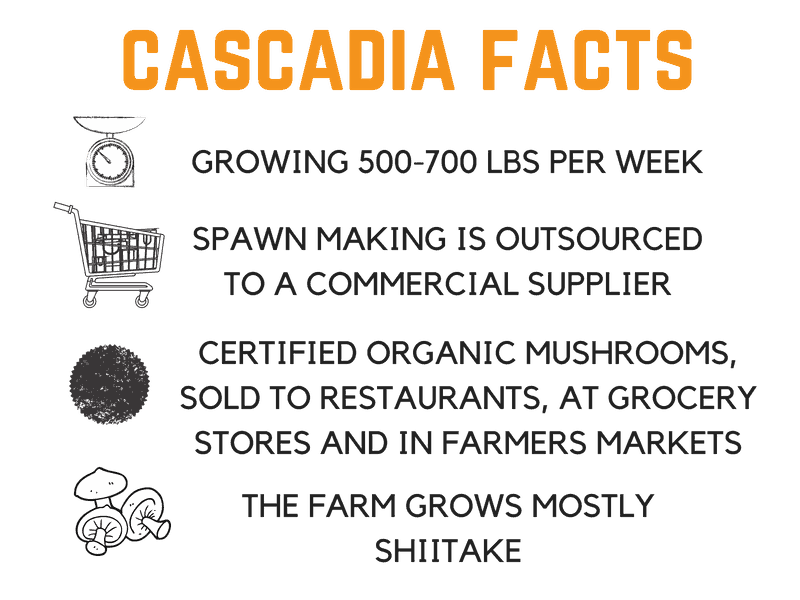
Buying Spawn Vs. Making Spawn
Cascadia Mushrooms does make some of their own spawn at the farm, but the majority of their production relies on other sources of commercially made spawn.
This is done for a number of different reasons… but it all boils down to focusing on what matters.
Alex’s customers want fresh, organic, and locally produced mushrooms. In order to deliver the best product, he prefers to focus on the last step of production, which is fruiting and harvesting.
He feels that if too much focus is placed on creating spawn, it takes away from the main goal of producing the best mushrooms.
It also reduces some of the liability, and leaves less room for something to go wrong with the cultivation process- whether it be scheduling the right amount of spawn, dealing with contamination issues, propagating and storing cultures, or a million other things that could affect production.
He prefers to let the spawn experts focus on making spawn, and the farming experts (Cascadia) focus on farming.
Buying spawn can make financial sense as well. A commercial spawn operation can be optimized to produce high quality spawn at a low price, and often times can be more cost effective than producing spawn in house. The bottom line is unless there is a really good reason to make your own spawn, it’s probably better just to source it elsewhere.

Incubation
A great wide door at the back of the lab leads directly into an impressive incubation area.
Walking among the endless rows of colonizing blocks, you can’t help but feel inspired. The tremendous amount of potential energy building in the room is palpable!
The Shiitake blocks are allowed to colonize for two and a half months, until they are fully browned. This extensive colonization period helps to produce the highest quality fruits and the best yield. Once they are ready, no special process is used to get them to fruit, other than simply removing the bag and placing into the grow room.
No soaking, smacking, or cold shocking required!
For grow bags, High Density Poly Ethylene (HDPE) bags are used, instead of the more common Poly Polypropylene (PP) grow bags.
Alex finds HDPE to be more durable. The PP bags have a tendency to stick together and break during mixing or transportation of the blocks.
If a bag breaks – even a little tear- there is a high chance of contamination occurring. Minimizing this risk is important.
I can see why they use these bags- I can’t tell you how many times I have had a PP bag break right in the corner while the spawn is being mixed. This is usually fixed pretty easily by placing a piece of masking tape over the tear, but would not be feasible for an operation making 1800 fruiting blocks per week.
The incubation area is naturally warmer than the fruiting room, made that way from the excess heat given off by the large number of colonizing blocks. At 74 deg F, the blocks can happily colonize at a healthy clip. At any given time, there are over 11,000 blocks at different stages of growth in this room.
The process of getting the bags into and out of the incubation area does leave some room for improvement though.
As mentioned before, one of the major costs of operating a mushroom farm is labor. Moving the bags from a cart onto the shelves in the incubation room, and back on a cart for transportation to the fruiting room takes a ton of effort. On a small scale it’s no big deal- but when you’re moving thousands of bags a week, every step adds up.
Alex has considered the idea of using large moveable shelves, which can be loaded with bags after inoculation, moved into the incubation room, and rolled directly into the fruiting room after colonization.
But even though it sounds like a no brainer, there are some issues with that method.
First of all, the bags are stacked a lot closer together during incubation than they would be for fruiting, so you would have to move them either way. Also, the incubation shelves are made of cheap lumber, which is cost effective for low humidity areas- but wouldn’t last long in the moisture of a grow room.
A compromise would be to have castors installed on the shelving for the grow room, so that the shelves could be rolled into the incubation area, and the bags could be loaded from there. This would at least save one step in the process, and is something he is seriously considering.
Fruiting Reishi In The Incubation Area
Alex does grow Reishi Mushrooms, but interestingly, only grows the antler form.
This is because the conditions in his grow room are focused on optimizing one strain of Shiitake, which grows at 60-65 deg F. His strain of Reishi prefers temperatures to be about 10 degrees warmer for fruiting.
For Reshi, they use custom made grow bags that are significantly taller, so that the antlers can grow happily inside the confines of the bag. Due to the high CO2 environment, the mushrooms continue to grow in these tall finger like projections, never taking on the traditional “conk” form. They are incubated, fruited, and harvested entirely in the incubation area.
Reishi is only grown for one flush, and sold as a dried product, to be made into a tea or other concoction.

Harvesting
What good is growing all these mushrooms if you aren’t going to harvest them?
Shiitake mushrooms are harvested only once, since second flushes are found to produce diminishing returns, and introduce unnecessary contamination risk.
Further, the time and labor required to take the blocks to a different area, dry them, soak them, and return to the grow room just isn’t worth it.
Alex is considering building another area specifically for getting a second flush of Shiitake, but hasn’t committed to that project just yet.
The other species (including Oysters, Lion’s Mane and Piopinni) are harvested multiple times over a number of weeks. The mushrooms are fruited continuously, and harvested as needed.
After the fruiting blocks are spent, they’re brought out the back of the grow room and into a compost pile.
Spent blocks are a waste material for mushroom growers, but can be a useful material for other farmers who are happy to take these blocks away for free.
The Grow Room
This is where the magic happens!
The grow room is directly beside the incubation area, and is the same size. It is in this room that mushrooms are also packaged for delivery.
The entire area is fed fresh air from a large air handler, which can cool or heat the room depending on external conditions. The air is delivered throughout the room in a large duct that runs along the ceiling. There are also misting nozzles along this duct to humidify the incoming air.
There is also a supplemental humidifier in the grow room, which can kick in during drier weather in order to bump up the humidity. It doesn’t look like much, but apparently can make a pretty big difference.
The Shiitake strain at Cascadia is super high quality, and produces exceptional fruits… but likes temperatures to be between 60-65 deg F. This cooler temp requirement is not always easy to achieve (especially in the summer months) but is a trade off for what is a top-nothch strain.
And, of course, every once in a while contamination issues can crop up.
For example, for some oyster species (especially King Oyster) can be susceptible to a condition known as “bacterial blotch” when grown in excessively wet conditions.
As the name implies, this is a bacterial growth that forms on the cap of the mushroom, and can render the infected fruit unsuitable for consumption. Proper management of humidity can usually eliminate this condition entirely.
This means preventing excessive water droplets from hanging out too long on the fruit body. If the caps are allowed to dry out every once and awhile, bacterial blotch won’t form.
That being said, trying to fruit such a variety of species in one grow room will often lead to issues. You can only optimize for one species, meaning that others may suffer from non-perfect conditions.
An interesting observation from Alex was that the contamination issues he has seen in the grow room took a while to develop.
He attributes this to the fact that it takes a number of years for the microflora to become established in the grow area. New grow areas will have naturally low populations of bacteria and other organisms, but over time it becomes more difficult to manage potential issues.
This is an important point- born from experience– and is easily overlooked by new growers.
You may not have any issues growing a certain species in the first few years, but after a while, contamination issues might show up out of the blue.
For Alex, this specific issue happened with his Lion’s Mane strain. It was so bad that he stopped growing Lion’s Mane entirely for over a year.
It seems that he has it under control now, but it does shows the importance of proper grow room management, and being prepared to respond to any potential issues.
Certified Organic
In today’s world of natural foods, Organic Certification is almost table stakes for any small scale farmer.
Cascadia Mushrooms produce is all certified organic, and is an important selling feature of their fresh mushrooms. Although it sounds like a hassle to get the proper certifications, Alex says it was actually not too hard to do, since the cultivation process is naturally organic.
As long as all the inputs are “Certified Organic” (sawdust, grain, etc) and no other chemicals are used in the process, the resulting harvest can be deemed organic.
Where Are They Sold?
Cascadia mushrooms sells about 500-700 lbs of fresh mushrooms per week to farmers’ markets around Bellingham, a number of grocery stores, and over 2 dozen restaurants throughout the state.
Fresh mushrooms, dried Reishi and various mushroom growing kits are also available through the Cascadia Mushrooms website.
Alex has considered expanding the farm in the past, and a strong demand definitely shows that there is room to grow in the market. For now though, he is satisfied with his level of production, which keeps himself and his 3 part time employees quite busy!
Although he grows mushrooms year-round, there is a seasonal aspect to the business.
The busy season is during the winter months, while there is a noticeable slowdown in the summer. Luckily this seems to mesh well with the natural challenges of producing mushrooms in the summer heat.

Why Cascadia Works
Not just anyone can throw up a couple of steel outbuildings and start growing gobs of Shiitake for sale into the local market.
So what is it that makes Cascadia a viable and flourishing operation?
Although it would be hard to sum it up in a few lines, I do have some thoughts on why Alex has been able to do what he does.
EXPERIENCED GROWER
Alex knows what he is doing, with skills honed over many years of trial and error.
Like many other growers, his first operation was a basement grow, which he scaled up over time.
He’s put a lot of thought into what works for his farm and his particular situation. The farm is built around those parameters.
FOCUS ON ONE SPECIES
They have identified what species is the most relevant to their area, and responded to what the market wants.
Of course, they still grow a variety of different species, but focusing on one strain of Shiitake really helps to nail down efficiencies on the farm.
OUTSOURCED SPAWN
Again, focusing on what matters- which is fruiting, harvesting, and delivering fresh mushrooms.
For the most part, they leave the spawn making to other experts. This way, they don’t have to worry about scheduling spawn and any other problems that could crop up with contamination.
YEAR ROUND GROWING
Since the mushrooms are grown in an indoor environment that is entirely climate controlled, they are able to grow the mushrooms year round.
Even though that can be tough during extreme weather, having a steady year round grow can help with cash flows.
CERTIFIED ORGANIC
High quality mushrooms, entirely organic and fresh are in high demand. Alex knows what his customers want, and is able to deliver.
Problems With Plastic Bags
As mentioned above, Alex uses HDPE bags for all the fruiting blocks at the farm.
But one major problem with plastic bags is the amount of waste created. This is an industry wide problem, and is definitely not specific to Cascadia Mushrooms.
The bags are cheap to produce, easy to use, and extremely effective- but not at all environmentally friendly. For the most part, they are one-use bags, and many of them do end up in the landfill.
One potential solution to this problem is to use bio-degradable bags.
As far as I know, there is still no workable version of this kind of bag available to commercial growers.
So what are mushroom growers to do?
Another potential solution is to use a bottle technique, where instead of bags, mushrooms are grown in reusable plastic bottles. This method is highly mechanized, and many farms use it effectively.
It’s actually really cool to see!
But switching the production method for a live farm, growing over 500 lbs per week is no easy task.
Cascadia is no longer the small operation it once was. Alex depends on the mushrooms for his livelihood, and so do his employees. Abruptly changing the main production method- from bags to bottle for example- could have unintended consequences.
Still, it is something he is putting a lot of thought into, and perhaps one day will start to move in that direction.
Mushroom Consulting
Are you a new grower looking for expert help? An expert grower trying to troubleshoot a specific issue? We could all use a little help sometimes.
That’s why Alex offers consultation for other mushroom farmers, where he shares his hard earned expertise to others in need of advice.
He can apply his expertise to help with business plans, designing farm models, and any other issue that a mushroom grower might be dealing with.
If you’re interested and want more information on these services, reach out to Alex by phone, or contact him directly through the Cascadia Mushrooms contact page.
Shiitake For Days!
Checking out any mushroom farm is always cool, but visiting Cascadia Mushrooms was definitely an awesome experience!
Seeing the sheer volume of fruiting blocks, and the highly optimized flow of this farm was really impressive to see.
I’m sure the residents of Washington State will be enjoying these awesome mushrooms for many years to come!
Thanks so much for checking out this Grower Profile. If I missed anything that you wanted to know about, be sure to leave a comment below- I’m always happy to share as much as I can.
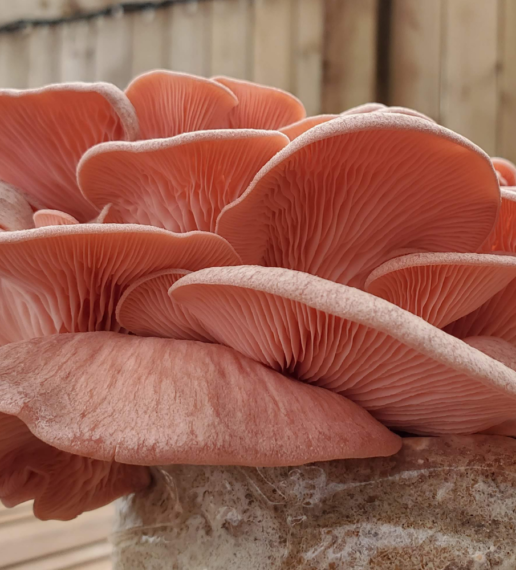
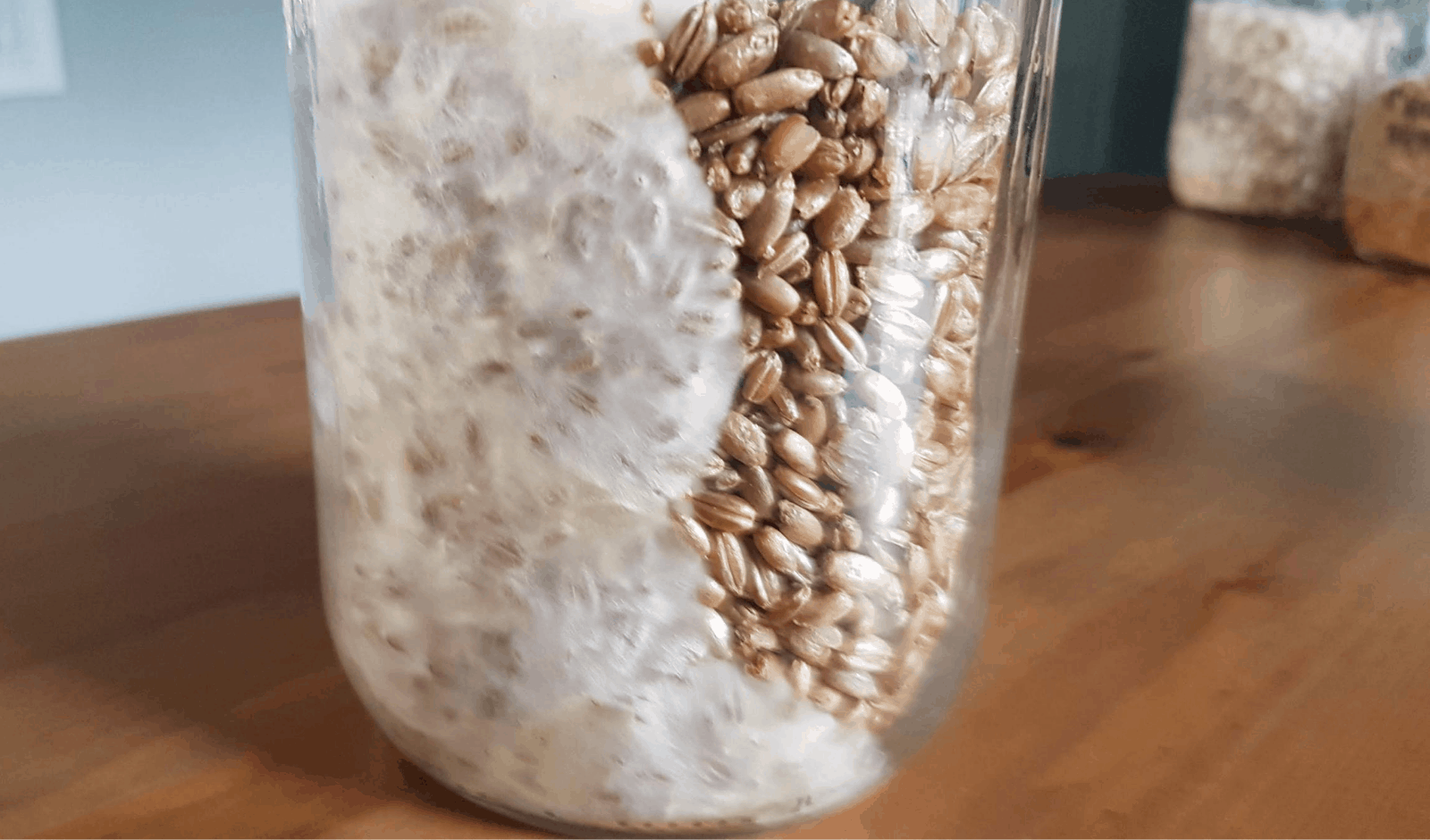
Super article. Love the specificity and also the logical flow of the processes.
Glad you liked it! Yes, the flow of the operation was absolutely perfect! You can tell he has put a lot of thought into how it should go, maximized for efficiency.
Je suis du même avis de M. Mary Bjoraker, je partage même son avis.
Je vois que M. Alex tient bon et va de l’avant. Pour le problème du recyclage des Sacs en plastique, il va de soit que cela doit être pris en considération dans l’avenir….et puis ce n’est pas seulement le Soucis de M. Alex mais de nous tous.
Encore merci M. Tony pour ce reportage, je le trouve très constructif. c’est bon de savoir.
Abed
Thanks for checking it out! Glad you enjoyed the article!
Hi, could you ask Alex, how many microns are the HDPE bags he uses? they are seen on the shelves that are high density but the important thing is to know how many microns it is! so they do not melt in the autoclave. Could you remove that doubt?
Looking for consultation if you do such? Regards,Julian